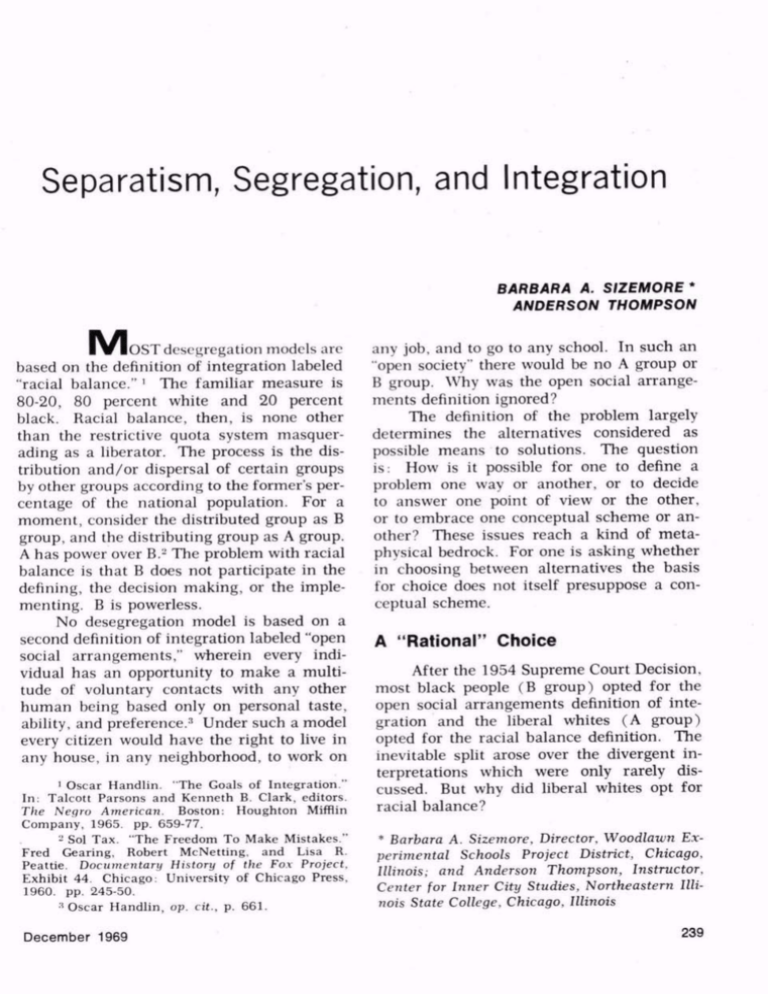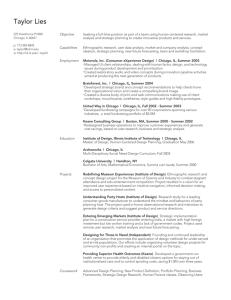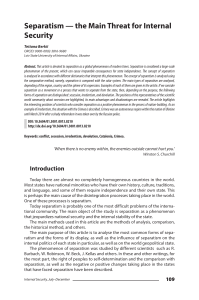
Separatism, Segregation, and Integration
BARBARA A. SIZEMORE *
ANDERSON THOMPSON
M
lOST desegregation models are
based on the definition of integration labeled
"racial balance." ' The familiar measure is
80-20, 80 percent white and 20 percent
black. Racial balance, then, is none other
than the restrictive quota system masquer
ading as a liberator. The process is the dis
tribution and/or dispersal of certain groups
by other groups according to the former's per
centage of the national population. For a
moment, consider the distributed group as B
group, and the distributing group as A group.
A has power over B. 2 The problem with racial
balance is that B does not participate in the
defining, the decision making, or the imple
menting. B is powerless.
No desegregation model is based on a
second definition of integration labeled "open
social arrangements," wherein every indi
vidual has an opportunity to make a multi
tude of voluntary contacts with any other
human being based only on personal taste,
ability, and preference. 3 Under such a model
every citizen would have the right to live in
any house, in any neighborhood, to work on
1 Oscar Handlin. "The Goals of Integration."
In: Talcott Parsons and Kenneth B. Clark, editors.
The Negro American. Boston: Houghton Mifflin
Company, 1965. pp. 659-77.
- Sol Tax. "The Freedom To Make Mistakes."
Fred Gearing, Robert McNetting, and Lisa R.
Peattie. Documentary History of the Fox Project,
Exhibit 44. Chicago: University of Chicago Press,
1960. pp. 245-50.
3 Oscar Handlin, op. cit., p . 661.
December 1969
any job, and to go to any school. In such an
"open society" there would be no A group or
B group. Why was the open social arrange
ments definition ignored?
The definition of the problem largely
determines the alternatives considered as
possible means to solutions. The question
is: How is it possible for one to define a
problem one way or another, or to decide
to answer one point of view or the other,
or to embrace one conceptual scheme or an
other? These issues reach a kind of meta
physical bedrock. For one is asking whether
in choosing between alternatives the basis
for choice does not itself presuppose a con
ceptual scheme.
A "Rational" Choice
After the 1954 Supreme Court Decision,
most black people (B group) opted for the
open social arrangements definition of inte
gration and the liberal whites (A group)
opted for the racial balance definition. The
inevitable split arose over the divergent in
terpretations which were only rarely dis
cussed. But why did liberal whites opt for
racial balance?
* B arbara A. Sizemore, Director, Woodlawn Ex
perimental Schools Project District, Chicago,
Illinois; and Anderson Thompson, Instructor,
Center for Inner City Studies, Northeastern Illi
nois State College, Chicago, Illinois
239
First, the agitation for integration was
often led by liberal whites who found them
selves in neighborhoods threatened by black
inundation. 4 The assumption was made that
black people were moving into white neigh
borhoods for the same reasons that white
people were moving to the suburbs: better
schools and better homes. An arrangement
to integrate all the schools " could eliminate
those moving for better schools, would force
white neighborhoods distant from black com
munities to share the burden of the black
blight, and would stall for time until some
better solutions could be found, for example,
urban renewal, Model Cities Programs, or
zoning laws.
Second, the abolition of powerlessness
of the B groups necessitates the surrender of
A group status. The model or theme which
serves as the foundation of Western defini
tions and alternatives in philosophy, history,
sociology, psychology, anthropology, and edu
cation is the myth of the white man. The
white male model symbolizes a belief in the
inherent superiority of all Western European
white men. An open society definition would
eradicate white supremacy and European
superiority (A group status). The option of
racial balance has no such requirement. In
fact, it reinforces the supremacy, for A has
power over B. The choice of racial balance,
then, was a rational choice.
Rational man acts for a reason. Four
suggested basic social components of that
action are: values, norms, the individual's
motivation for action, and the situational
factors.6 The values are the broad-ended goal
statements upheld by the rules, laws, regula
tions, and standards (norms) executed by
the individual properly motivated to obedi4 Robert Grain. The Politics of School De
segregation. Chicago: Doubleday & Company, Inc.,
1969. pp. 112-30.
'' Gregory Coffin. "Moving Toward Integra
tion." Illinois Education, November 1968. See also
literature on Evanston, Illinois, school desegrega
tion.
c Neil J. Smelser. Theory of Collective Be
havior. New York: The Free Press of Glencoe, Inc.
pp. 24-46. See also: Edward Shils and Talcott
Parsons. Toward a General Theory of Action.
Harper Torchbooks. New York: Harper & Row,
Publishers, 1951. pp. 47-189.
240
ence and conformity by socialization or the
provision of skills, knowledge, and informa
tion (situational factors). Models or images
are both the means of socialization, which
defines a person's place in the world, and of
social control, which confines one's place in
that world.
For example, the values of democracy,
love, peace, and brotherhood were supported
by the civil rights movement under the lead
ership of Dr. Martin Luther King, Jr. 7 These
human values have been manifest in the
black community for some time. They are
revealed in the extended black family,
through its belief in individualism, its con
fidence in education, and its faith in Chris
tianity. 8 But, in its powerlessness, the black
family could not make white institutions sup
port these values. It never mobilized its
resources adequately to win that control.
Additionally, although democracy, love,
peace, and brotherhood are the declared
values of the white community, the white
family does not support them. Myrdal calls
this lack of support "An American Di
lemma." ft He attributes this failure to the
"psychic resistance" of those who need to sus
tain their belief in white supremacy. But an
other explanation might be the existence of
another value system . . . undeclared. . . .
That undeclared value system could well be:
male superiority, 10 white supremacy, Euro
pean superiority, 11 and the superiority of
people with money. 1 - If this is the value
system, three B groups emerge: women, nonwhites and non-Europeans, and the poor.
" M artin Luther King, Jr. Where Do We Go
From Here: Community or Chaos'! New York:
Harper & Row, Publishers, 1967. pp. 1-66.
a Andrew Billingsley. B lack Families in White
America. Englewood Cliffs, New Jersey: PrenticeHall, Inc., 1968.
0 Gunnar Myrdal. An American Dilemma.
New York: Harper & Row, Publishers, 1944. pp.
1027-34.
10 Lionel Tiger. Men in Groups. New York:
Random House, Inc., 1969.
11 Albert Memmi. The Colonizer and the
Colonized. B oston: Beacon Press, 1965. For de
tailed description, see: Harold Cruse. The Crisis
of the Negro Intellectual. New York: Morrow and
Company, Inc., 1967.
12 Ferdinand Lundberg. The Rich and the
Super Rich. New York: Bantam Books, Inc., 1968.
Educational Leadership
"Things Fall Apart"
These observations suggest that B
groups must go beyond mere analysis of
A group studies of B groups. For, if these
conditions are "to be turned upside-down,"
in the words of Fanon, 13 it must be deter
mined whether or not A groups are capable
of changing their behavior. In his most
penetrating novel, Chinua Achebe has the
hero, Okonkwo, ask a friend, Obierika, "Does
the white man understand our customs about
land?" Obierika answers:
"The white man is very clever. He came
quietly and peaceably with his religion. We
were amused at his foolishness and allowed
him to stay. Now he has won our brothers,
and our clan can no longer act like one. He has
put a knife on the things that held us together
and we have fallen apart." 1 4
B groups must study A groups and their
alien models and images created and super
imposed on B group cultures and incor
porated into their lives; for these exert some
measure of control over the group.
Segregation is such a control: the con
dition of separatism which occurs when the
A group (whites) forces the B group (blacks)
to remain apart from the A group. A has
power over B. The value is white supremacy;
the norm (law) is segregation. Both A and
B group members are motivated to conform
to the belief in B group inferiority and worthlessness and the fear of A group reprisal by
models and images. lr'
Separatism is the condition of separa
tion which occurs when B group decides for
itself to separate from A group. A is equal
to B. The v ilue is usually some aspect of the
pursuit of happiness (cultural preservation,
a certain way of life, survival, or group mo
bility). Most previously excluded groups
(B groups) attempted to improve their con
ditions from a separated vantage point, for
13 Frantz Fanon. The Wretched of the Earth.
New York: Grove Press, Inc., 1963. pp. 29-74.
14 Chinua Achebe. Things Fall Apart. Lon
don: Heinemann, 1958.
'" Allison Davis, Burleigh and Mary Gardner.
Deep South. Phoenix Books. Chicago: University
of Chicago Press, 1941. pp. 20-24.
December 1969
example, Amish, Muslims, immigrants, and
Catholics. 10
The intransigence of the firmly en
trenched A group causes the B group to use
the only resource available, people. From
the pseudospecies declaration, "We are the
chosen people," grounded in religion, a
strong group identity specification emerges
attached to a territorial imperative. 17 This
combination leads to an intense nationalism
which transforms itself into a powerful group
cohesion and support system projecting a
negative identity. 1 " The negative identity
designates A group as harmful and B group
excludes A group, whereupon the need for
cooperation is noted within B group. Within
the confines of B group, the human values
are practiced. B group members choose each
other for jobs, services, and support. 10
This model for group mobility developed
because the individual mobility model which
worked for the A group (Protestant Ethic,
Horatio Alger. etc.) failed the B group. Indi
vidual mobility models work for members of
the "in" group. It is possible that separatism
will be necessary as long as A groups have
power over B groups. The blind cannot
compete with the seeing. They need support.
All B groups do. Greeley and Rossi discov
ered this in their study of Catholic
Americans. 20
On the other hand, if one believes all
111 Barbara A. Sizemore. "Separatism: A
Reality Approach to Inclusion?" In: Robert L.
Green. Racial Crisis in American Education. C hi
cago: Follett Publishing Company. 1969. Chap
ter 12.
17 Erik H Erikson. Identity. Youth, and
Crisis. New York: W. W. Norton and Co., Inc.,
1968. See also: Robert Ardrey. Territorial Impera
tive. New York: Atheneum Publishers, 1966.
'«Erik H. Erikson, i bid., pp. 172-76.
1!) Stokely Carmichael and Charles V. Hamil
ton B lack Power. Vintage Books. New York: Ran
dom House, Inc.. 1967. See also: Nathan Glazer
and Daniel Patrick Moynihan. B eyond the Melting
Pot: The Negroes, Puerto Ricans, Jews, Italians and
Irish of New York City. C ambridge, Massachusetts:
Massachusetts Institute of Technology Press, 1963.
-'" Andrew M. Greeley and Peter H. Rossi.
The Education of the Catholic Americans. N a
tional Opinion Research Center Monographs in
Social Research. Chicago: Aldine Publishing Com
pany, 1966. p. 151.
241
In order to ensure B groups of full, free,
and constructive participation in decision
making, human values must be supported for
liberation and survival if and when A groups
refuse to support these human values. To
do otherwise would mean to adopt a value
system which destroys one's identity and any
fj
possibility of true integration.
men are equal under God, desegregation
models need practices and policies which
support the values manifest in such a belief.
Participation in such models must be volun
tary and must respect the rights of people to
live, work, and go to school anywhere. There
fore, the involvement of all participants in
the defining and decision-making process is
imperative. Such a model has been con
ceived by the Chicago Midwest Desegrega
tion Institute. 21
elusion. The Midwest Program in School Desegre
gation and Equal Educational Opportunity. In
dianapolis Workshop: A Progress Report. Funded
by Grant #OE6-0-8-000365-4515 (036) under Title
IV of the Civil Rights Act of 1964 by the U.S. Office
of Education, February 1969.
21 Jacob Carruthers. "The Black View of the
Workshop." In: Toward a Model of Relevant In-
The Supervisor:
New Demands
°
New Dimensions
By the ASCD Commission on
Problems of Supervisors and Curriculum Workers
Harold T. Shafer, Chairman
Edited by William H. Lucio
Contents
• New Demands, New Dimensions
"The Setting and New Challenges," C. Taylor Whittier
• Coping with Role Realities
"Helping Adults Change," Gordon J. Klopf
"Influencing Professional Negotiation," William F. Young
"Assessment of Learning Outcomes," J. Thomas Hastings
"Coordinating the Team," George W. Denemark
• Career Development
"Implications for Career Development," William H. Lucio
"The Supervisor and His Professional Identity," Jack R. Frymier
With a preface by Muriel Crosby, a foreword by William H. Lucio,
and an introduction by Harold T. Shafer.
128 pages
N EA Stock Number: 611-17782
$2.50
Association for Supervision and Curriculum Development, NEA
1201 Sixteenth Street, N.W., Washington, D.C. 20036
242
Educational Leadership
Copyright © 1969 by the Association for Supervision and Curriculum
Development. All rights reserved.









